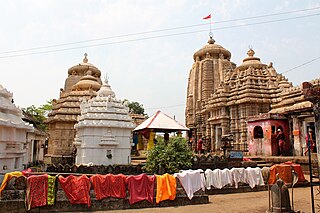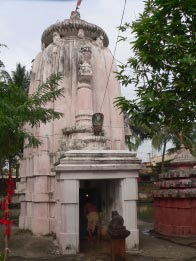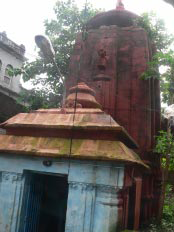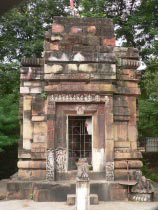
The Kapilesvara temple is a Hindu temple dedicated to Shiva located in the south western outskirt of the village Kapilesvara, Old Town, Bhubaneswar, Odisha, India. It is located at the end of Kapilesvara road leading from Lingaraj temple to Kapilesvara Village. The presiding deity is a Siva-lingam at the center of a circular yonipitha inside the sanctum. It is a living temple, facing towards east and maintained by Kapilesvara Temple Trust Board. The temple is situated within the precinct along with 33 other monuments. The precinct is located on the northern embankment of Manikarnika tank over an area of 44.00 square metres.
Nilakanthesvara Shiva Temple is a temple in Orissa, India, located on the western embankment of the Bindusagar tank. It is situated on the left side of the lane branching from the road leading from Kedar Gouri chowk to the Vaitaḷa deuḷa in Bhubaneswar, the capital state of Orissa. The temple faces east. The temple's enshrining deity is a circular yoni pitha with a chlorite Siva lingam. The temple is made out of sandstone. The present temple is a recent construction over the remains of an earlier one. The building material is old but the entire structure now has cement plaster and an enamel point.

Lokanatha Siva Temple also Amunha Deula is an 11th-century AD temple in Bhubaneswar in the state of Odisha, India. It represents a proto type of Lingaraja in a miniature form. Lokanatha Siva temple is located in front of the Lingaraja temple in the south eastern corner across the road and adjacent to Lingaraja Temple Police Station in Old Town, Bhubaneswar. Until 1972 the temple was buried from all sides up to the bandhana portion, giving an impression as if the temple had no entrance. Hence people called it Amuha deula. In 1972 Debala Mitra conducted an excavation in front of the northern wall and exposed the entrance. The sanctum was empty. However, on the basis of the local traditions and the sculptural embellishment on the outer wall it was ascribed to Lord Siva. It is now known both as Lokanatha Siva and Amuha deula. People ascribe the temple to the Kesharis (Somavamsis). Except the entrance all other sides it is buried up to the bandhana.
The Bhringeswara Shiva temple is an 8th century Hindu temple situated on the foothills of Dhauli and the left bank of the Daya River, in the southeastern outskirts of Bhubaneswar(India) in the village Khatuapada. The temple is facing towards west and the presiding deity is a circular yoni pitha with a hole at the centre. The temple is made of light grey sandstone. The temple is renovated one from bottom to the top by employing the earlier materials. This temple is now under the protection of Odisha State Archaeology.
Patalesvara Siva Temple – I is a temple dedicated to Lord Shiva, located in Old Town, Bhubaneswar, Odisha,India. This temple dates back to 13th century, and belongs to the Ganga era. At present, this temple is situated inside the compound wall of a private residence.
Svapnesvara Siva temple is in Gourinagar, Old Town, Bhubaneswar, the capital of Odisha,India. It is 200 m northeast of Purvesvara Siva temple. The temple is facing east. The 2 m2 sanctum is empty.
Bhrukuteswar Shiva Temple is situated in Yamesvara Patna, Old Town, Bhubaneswar in Odisha, India. It is a single structure pidha deul without any frontal porch. According to the local people this temple was built by the Kesaris (Somavamsis).
The Somesvara Siva temple is located in the Kharakhia Baidyanath temple precinct in Kharakhia Vaidyanath Sahi, Old Town, of Bhubaneswar. It is located approximately 300 metres south of Lingaraja temple. Visitors may approach the site on the left side of Baidyanath Road leading from Lingaraja temple to Kapilesvar. It is a living temple and faces towards the west. The enshrined deity of this temple is a Siva lingam within a circular yonipitha at the center of the sanctuary located 0.93 metres below the chandrasila. The temple is under the care and maintenance of Babulal Makaddam Badu Mohapatra, the chief priest of the temple, on whose private land the temple stands.

Paradaresvara Siva Temple is a 13th-century AD temple in Bhubaneswar, Odisha. The time period of its construction is estimated from its architectural features and it suggests that the temple must belong to the ganga period. Paradaresvra Siva temple is situated in the Gosagaresvar temple precinct. It is located on the left side of Ratha road old town, Bhubaneswar. It is located at a distance of 1 km west of Lingaraja Temple and 1 km south of Ananta Vasudev, 300 metres southwest of Ramesvara Temple and 200 metres northwest of Vaital Temple. The temple is facing towards east. The presiding deity is only a circular yonipitha in the cella that measures 3 square metres. The lingam is missing.
Gangesvara Siva Temple is situated within a precinct on the left side of the Ganges–Yamuna road Old Town, Bhubaneswar, Orissa, India. It is located at a distance of 200 metres north-east of Lingaraj temple, 50 metres north of Lakhesvara temple across the road, 200 metres south of Subarnesvara and 100 metres east of Gourisankar temple. The temple is facing towards east. The presiding deity is a Siva lingam within a circular yonipitha. It is a living temple and maintained by the Ganga YamunaSangathana.
Ladu Baba Temple is a temple in Bhubaneswar, Odisha, India. It was built in the 13th century AD and was formerly known as Kainchhi Temple.

The Tirthesvara Siva temple is a Hindu template located in Bhubaneswar, the capital of Odisha, India.

Mangalesvara Siva Temple is a Hindu temple located in Bhubaneswar, Orissa, India. It is located at Lat- 20◦ 14’ 38" N., Long- 85◦ 50’ 38" E., and at an elevation of 45 ft.
Papanasini Siva Temple is an abandoned Hindu temple located in Bhubaneswar, Orissa, India.

The Talesvara Siva temple is a Hindu temple in Bhubaneswar, Odisha, India.
Subarnesvara Siva temple is situated on the left bank of Lingaraja west canal, Bhubaneswar, Orissa, India. The east facing ancient temple enshrines a Siva lingam within a circular yoni pitha in the sanctum measuring 2.35 square meters.

Suka Temple is an abandoned and unused temple in Bhubaneswar, the capital of Odisha, India. The temple is devoted to saptaratha and the presence of female counterparts of the dikpalas in the upara jangha. This was built in the matured phase of temple building tradition of Odisha.
Sukutesvara Temple located in the old town of bhubaneswar, Odisha,India,serves as purpose for community gathering. The preceding deity in this temple is a Siva- lingam situated at the centre. The temple observes various religious sacraments like Mahasivaratri, Chandipatha and Rudrabhisekha.

Astasambhu Siva Temples is a collection of 8 Hindu temples dedicated to Lord Siva located in Bhubaneswar, the capital of Odisha, India.
Chakresvara Shiva temple is a living Hindu temple built in 10-11 AD dedicated to Lord Shiva at Hatiasuni lane, Rajarani Colony, Bhubaneswar of Odisha, India. The deity, lingam, is in a circular yonipitha inside the sanctum. The temple is surrounded by private residential buildings on its eastern and northern side and chakresvara tank in the west. It is of great significance as rituals like Shivaratri, Diwali, and Sankranti are observed here. Also this temple serves as a purpose of a sacred place for 'Thread Ceremony, Rudrabhiseka, Chandrabhiseka.'









